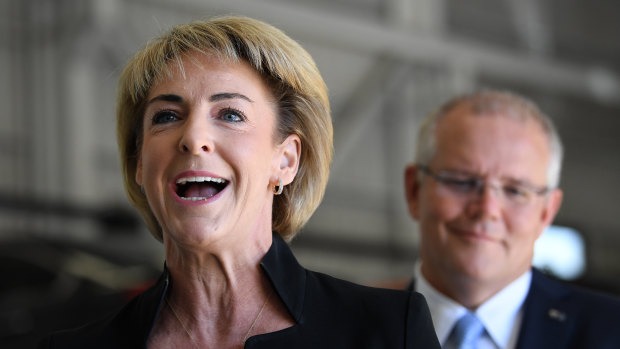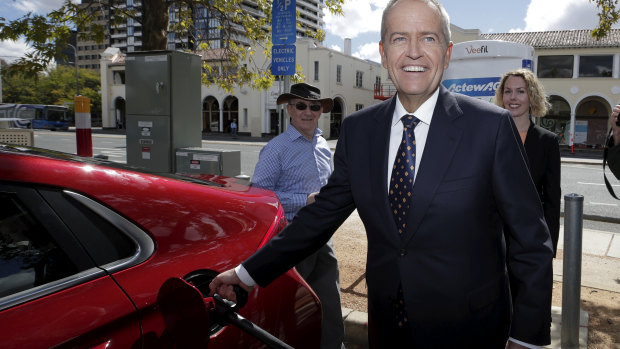This was published 5 years ago
Opinion
Doughnut election: Shorten short on detail, Morrison a messaging mess
David Crowe
Chief political correspondentThe natural interest in the horse race of politics makes it easy to overlook the problems for both sides of politics this week with the detail of what they offer Australian voters.
Scott Morrison found himself in a messaging mess with his claims this week about electric cars and the hit to motorists from Labor's plan for stricter emissions standards.
Bill Shorten found himself light on detail for his climate change plans and vision for cars.
Morrison's strong suit is tax. He does not convince everyone with tax cuts worth $302 billion over the decade ahead, but he has a compelling message to many voters worried about the cost of living.
As reported last Saturday, more than 1 million workers earning $90,000 a year would be $1000 a year better off under the Coalition's tax proposals from June 2022 compared with the Labor plan.
This is not a question about a tax cut that is two or three elections away. This is about a tax cut that would have to be legislated in the next term of Parliament. The moment to decide the tax cut is now.
Labor dismisses this Coalition pledge on the grounds the median salary is well below $90,000 and Shorten offers bigger tax cuts to all those earning less than $48,000.
This is a classic contest between a Labor pitch to those on lower incomes and a Liberal pitch to the "aspirational" workers who earn more now and expect to move up the income scale. Morrison makes no bones about this message.
The mystery is why he allowed the budget to sink without a trace this week. There was barely a debate about the tax benefits.
Morrison waged war instead on electric cars. The scale of this mistake was obvious in the way he dialled back the rhetoric as the week went on.

Small Business Minister Michaelia Cash went on the attack over electric cars.Credit: AAP
Two days after Michaelia Cash told voters she would "save their utes" by stopping Labor from mandating electric cars, Morrison did not even take a casual swipe at Shorten about it when calling the election.
For a moment, the government that promised to "stop the boats" sounded like it wanted to stop the future. This played to the deepest problem for the Liberals and Nationals in recent years – the sense that they are against change, whether it is same sex marriage, solar panels, wind turbines or electric cars.
There was an easy way for Morrison to challenge the Labor policy on cars and climate change. It's called fairness. Wealthier car buyers will be the early adopters for electric cars, which means they will escape fuel excise that costs everyone else $18 billion a year.
Shorten sets his targets with no solutions for this and other obvious problems. How would a Labor government deal with a huge fall in fuel excise revenue? How would it make the transition fair? Would it impose a distance charge so all vehicles, petrol or electric, would incur the same tax?
That is just the start of the questions. A report to government agencies by Energeia last May forecast electric cars would make up 22 per cent of new sales by 2030 with a "no intervention" scenario. Shorten wants to lift this to 50 per cent but says nothing about the intervention he would make to achieve his goal.
Shorten's policy has a gap as intriguing as a new photograph of a black hole. You can see the void but have to guess and what lies within.
Electric cars have big advantages, not least cleaner air and the chance to move beyond a reliance on oil from the Middle East, but the enthusiasts for these vehicles cannot expect voters to give them a blank cheque at the election.
Moving from "business as usual" to 50 per cent involves real costs on the commonwealth. What are they? How big would the subsidies become? When would taxpayers get their money back? Shorten skates over these details.

Opposition Leader Bill Shorten at an electric vehicle charging station in Canberra.Credit: Alex Ellinghausen
The government's allies no doubt believe the media has made it too easy for Labor, but the biggest gift to Shorten this week was Morrison's warning the electric car target would "end the weekend". It was hysterical.
Morrison's warning about Labor's plan for stricter fuel standards, specifically that it would add $5000 to the cost of new cars, was also misleading when there was no need to distort the facts to score a point.
The $5000 claim relied on the worst-case assumption about costs with no mention of the benefit.
The Labor proposal, an emissions standard of 105 grams of carbon a kilometre, was one of three benchmarks considered in detail by the Department of Infrastructure and Regional Development when Josh Frydenberg was energy minister and Paul Fletcher was cities minister. The other benchmarks were 119 grams and 135 grams per kilometre.
This came very close to being government policy. Just how close was apparent in the press release Frydenberg and Fletcher issued on December 20, 2016, to claim motorists would save $519 a year on their fuel bills.
That's right. The plan now pursued by Labor was acclaimed as a gift to motorists by the Coalition just three years ago.
The problem is the cost of buying and maintaining a car that meets the stricter standard. The same report said the capital and compliance cost would be $1921 if the 105 gram standard applied but only $1441 for the 119 gram standard and just $826 for 135 grams.
Voters may well decide the costs are not worth the risks of the change, in which case Shorten is in serious trouble. Once again, the key feature of his policy is the gap in the middle. He does not say when the 105 gram standard would start. This makes it impossible to cost with precision.
What the government did not want anyone to know was that motorists and the country as a whole would get a net benefit from the Labor fuel standard.
If the puns about a "car-bon tax" were excruciating, the numbers were worse. Under the department's regulation impact statement, the net benefit of the 105 gram target was $13.9 billion over two decades to 2040. Again, the stricter carbon standard had the highest benefit.
The fuel savings were forecast at $27.5 billion, offset by $16.2 billion in total costs. The benefit of the cut to carbon emissions was another $2.7 billion from a reduction of 231 million tonnes of greenhouse gases by 2040. This produced the net benefit of $13.9 billion.
Instead of relying on its own department’s analysis, the government cherry-picked estimates from the Australian Automobile Association in a report in August 2016, which using modelling by the Centre for International Economics.
The medium scenario for the additional cost per vehicle was $2371 in the AAA and CIE report. The worst-case scenario was $4863. This was the basis for Morrison’s claim about motorists paying $5000.
The government did not mention that the next page of the AAA report showed that the cost to motorists would be offset by savings on fuel, just as the department’s study had found.
The additional costs were $13.9 billion while the fuel savings were $20.8 billion in the worst-case scenario for the AAA, while there was an $800 million in benefits from cutting greenhouse gases. The net benefit was $7.7 billion.
The policy debate this week saw one side attempt a misleading scare campaign while another dodged questions on detail. The electric car debate was a taste of things to come in this campaign.
Australians will be offered more than a few policy visions in the weeks ahead. Most will be smothered in sugar but will have a hole in the middle. Whether they are healthy is up to the voter. The doughnut election is on.
David Crowe is the Herald's chief political correspondent.